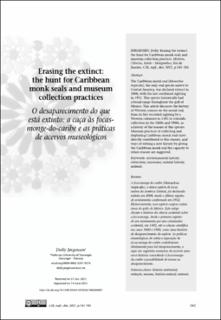| dc.contributor.author | Jørgensen, Dolly | |
| dc.coverage.spatial | Sentral-Amerika | en_US |
| dc.date.accessioned | 2022-02-10T09:18:13Z | |
| dc.date.available | 2022-02-10T09:18:13Z | |
| dc.date.created | 2022-02-07T18:29:22Z | |
| dc.date.issued | 2021-12 | |
| dc.identifier.citation | Jørgensen, D. (2021) Erasing the extinct: the hunt for Caribbean monk seals and museum collection practices. História, Ciências, Saúde-Manguinhos, 28, 161-183. | en_US |
| dc.identifier.issn | 0104-5970 | |
| dc.identifier.uri | https://hdl.handle.net/11250/2978169 | |
| dc.description.abstract | The Caribbean monk seal (Monachus tropicalis), the only seal species native to Central America, was declared extinct in 2008, with the last confirmed sighting in 1952. This species historically had a broad range throughout the gulf of Mexico. This article discusses the history of Western science on the monk seal, from its first recorded sighting by a Western colonizer in 1492 to scientific collection in the 1800s and 1900s, as a history of the erasure of this species. Museum practices of collecting and displaying Caribbean monk seals have directly contributed to this erasure, and ways of writing a new history by giving the Caribbean monk seal the capacity to refuse erasure are suggested. | en_US |
| dc.description.abstract | A foca-monge-do-caribe (Monachus tropicalis), a única espécie de focas nativa da América Central, foi declarada extinta em 2008, tendo o último registro de avistamento confirmado em 1952. Historicamente, essa espécie ocupou vastas áreas do golfo do México. Este artigo discute a história da ciência ocidental sobre a foca-monge, desde o primeiro registro de seu avistamento por um colonizador ocidental, em 1492, até a coleção científica nos anos 1800 e 1900, como uma história de desaparecimento da espécie. As práticas museológicas de coleta e exposição de focas-monge-do-caribe contribuíram diretamente para tal desaparecimento, e aqui são sugeridas maneiras de escrever uma nova história concedendo à foca-mongedo-caribe a possibilidade de recusa ao desaparecimento. | en_US |
| dc.language.iso | eng | en_US |
| dc.publisher | Casa de Oswaldo Cruz, Fundação Oswaldo Cruz | en_US |
| dc.relation.uri | https://www.scielo.br/j/hcsm/a/7HhHv8ssnBxYNr8DF9p77nL/?format=pdf&lang=en | |
| dc.rights | Navngivelse 4.0 Internasjonal | * |
| dc.rights.uri | http://creativecommons.org/licenses/by/4.0/deed.no | * |
| dc.subject | utrydding | en_US |
| dc.subject | miljøhistorie | en_US |
| dc.subject | naturhistorie | en_US |
| dc.subject | museer | en_US |
| dc.title | Erasing the extinct: the hunt for Caribbean monk seals and museum collection practices | en_US |
| dc.title.alternative | O desaparecimento do que está extinto: a caça às focasmonge-do-caribe e as práticas de acervos museológicos | en_US |
| dc.type | Peer reviewed | en_US |
| dc.type | Journal article | en_US |
| dc.description.version | publishedVersion | en_US |
| dc.subject.nsi | VDP::Humaniora: 000::Historie: 070 | en_US |
| dc.source.pagenumber | 161-183 | en_US |
| dc.source.volume | 28 | en_US |
| dc.source.journal | História, Ciências, Saúde-Manguinhos | en_US |
| dc.identifier.doi | 10.1590/S0104-59702021000500007 | |
| dc.identifier.cristin | 1998751 | |
| dc.relation.project | Universitetet i Stavanger: IN-11621 | en_US |
| dc.relation.project | Norges forskningsråd: 283523 | en_US |
| cristin.ispublished | true | |
| cristin.fulltext | original | |
| cristin.qualitycode | 1 | |

